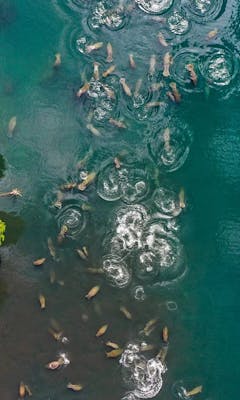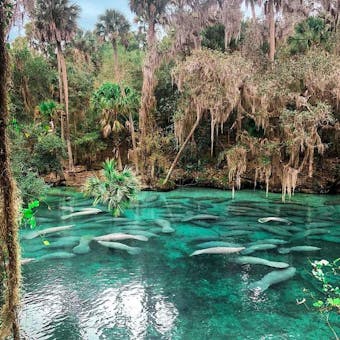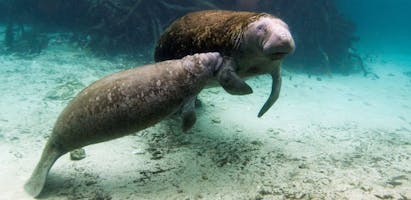Free Shipping on orders of $49+ | Signup for Direct Rewards
Free Shipping on orders of $49+ | Free Store Pickup | Signup for Direct Rewards
Free Shipping on orders of $49+ | Signup for Direct Rewards
Free Shipping on orders of $49+ | Free Store Pickup | Signup for Direct Rewards

Who doesn’t love talking about manatees? They’re cute, generally harmless and non-aggressive (unless you catch them in a mating herd), and certainly nothing else could possibly be considered the ocean’s potatoes. Once thought to be mermaids by ancient mariners, these little sea cows have become quite beloved in the ocean adventure community, much of which likely has to do with the awareness being spread about their need for conservation.
In Northern Florida, manatees are regularly abundant. They enjoy warm waters in the mid-seventies and love cruising through fresh water springs and rivers in the north. In the winter months, though, as the water temperatures shift a few degrees down, they follow the warm waters south where we can start to see them more frequently along Miami coastlines and in the Florida Keys. Since they’ll be around more of Florida in these coming months, let’s get to know our local manatees a little better so we can understand what they need and how best to respect them and their environment.
You may be wondering where these animals are when not enjoying the Florida Keys. Well, much like birds and some humans, they go south for the winter and stay up north through warmer months. They can be found all along the East Coast when waters are warm, sometimes, though rarely, as far north as Massachusetts.
But as soon as the chill starts to bring waterway temperatures below 68-degrees, they seek warmer waters in the southern states, which we Floridians are so grateful for!
Manatees are often called sea cows because, like land cows, they are herbivores and feed on seagrass, weeds, and algae. They are rather impressive eaters since they can munch on about a tenth of their own body weight a day. That can be anywhere from 30-100 lbs of food a day!
It’s also good to know that manatees don’t really have any predators. While sharks and alligators could be predators, manatees don’t spend much time in the same waters with them so it’s not exactly common for them to attack manatees. Unfortunately, the biggest threat to the manatee population is human activity via boating, litter and pollution, and destruction of seagrass beds and mangroves.

Manatees are incredibly unique animals. This may surprise you, but manatees are actually most closely related to elephants. With their animated snouts just like an elephant’s trunk, their grey coloring, and even the nails at the end of their front flippers, they’re practically elephants of the water.

Like we mentioned earlier, humans are the biggest threat to the manatee population. So, knowing the manatee population is making its way south, how can we exhibit mindful behavior to help prevent harmful incidents to manatees?
1. One quick and easy step you can take to keep manatees safe this winter is by wearing polarized sunglasses. Polarized sunglasses help to cut any glare from the water. So when you’re out boating or kayaking or paddleboarding, you’ll be able to better see their little snouts poke just above the surface and their large, dark shadows moving slowly just beneath the water.
2. Once you can see the manatees, you may get excited. It’s really cool to see wild marine life, we get it! But be sure to keep a respectful distance from these, and other, animals. When you’re out and about, you prefer that strangers respect your space and don’t touch you, right? So show that same respect around wild animals. Keep a distance and never ever touch the animals unless there is an emergency.
*It is also recommended to call this Wildlife Alert Hotline at (888) 404-3922, #FWC, or *FWC from your cell phone if you see a manatee that’s sick, injured, dead, or tagged.
3. Be mindful of your litter. We know, you would never intentionally toss items into the water. But when you’re out on the water having a good time, sometimes things like plastic bags, fishing line, cups, or other items can fly off the boat. Whenever possible, always go back and gather what was lost. It helps to tie down anything on a boat or other water vessel to prevent this from happening. Additionally, if you see trash in the water, remove it and properly dispose of it if you can.
If you visit Florida often or have lived here a while and spend any time around water, you’ve likely seen a manatee somewhere at some point in time. You may have even intentionally experienced these animals by visiting them in Crystal River or another popular manatee spot, and hopefully now you know a little more about them. Just remember to always be respectful of all wildlife and mindful of manatees as you go boating, kayaking, paddleboarding, snorkeling, diving, and any other fun you’re having in a natural water environment this manatee season.

A: Call the Wildlife Alert Hotline at (888) 404-3922, #FWC, or *FWC from your cell phone if you see a manatee that’s sick, injured, dead, or tagged.
A: Please, never touch any marine wildlife or even get too close to them. Being stalked or approached by a strange animal (that’s you!) can be highly stressful for manatees and other wildlife.
A: Any small planet-friendly act can have a big impact on all marine wildlife. Whether that’s gradually switching to a plastic-free lifestyle, picking up litter where you see it, or spreading awareness about manatees and other animals.
A: There are roughly 13,000 manatees worldwide, but in the Southeastern U.S. and Puerto Rico, there are more than 6,500 manatees. This is a great improvement from 30 years ago when the Florida manatee population was approximately 1,200.
A: A group of manatees is called and aggregation